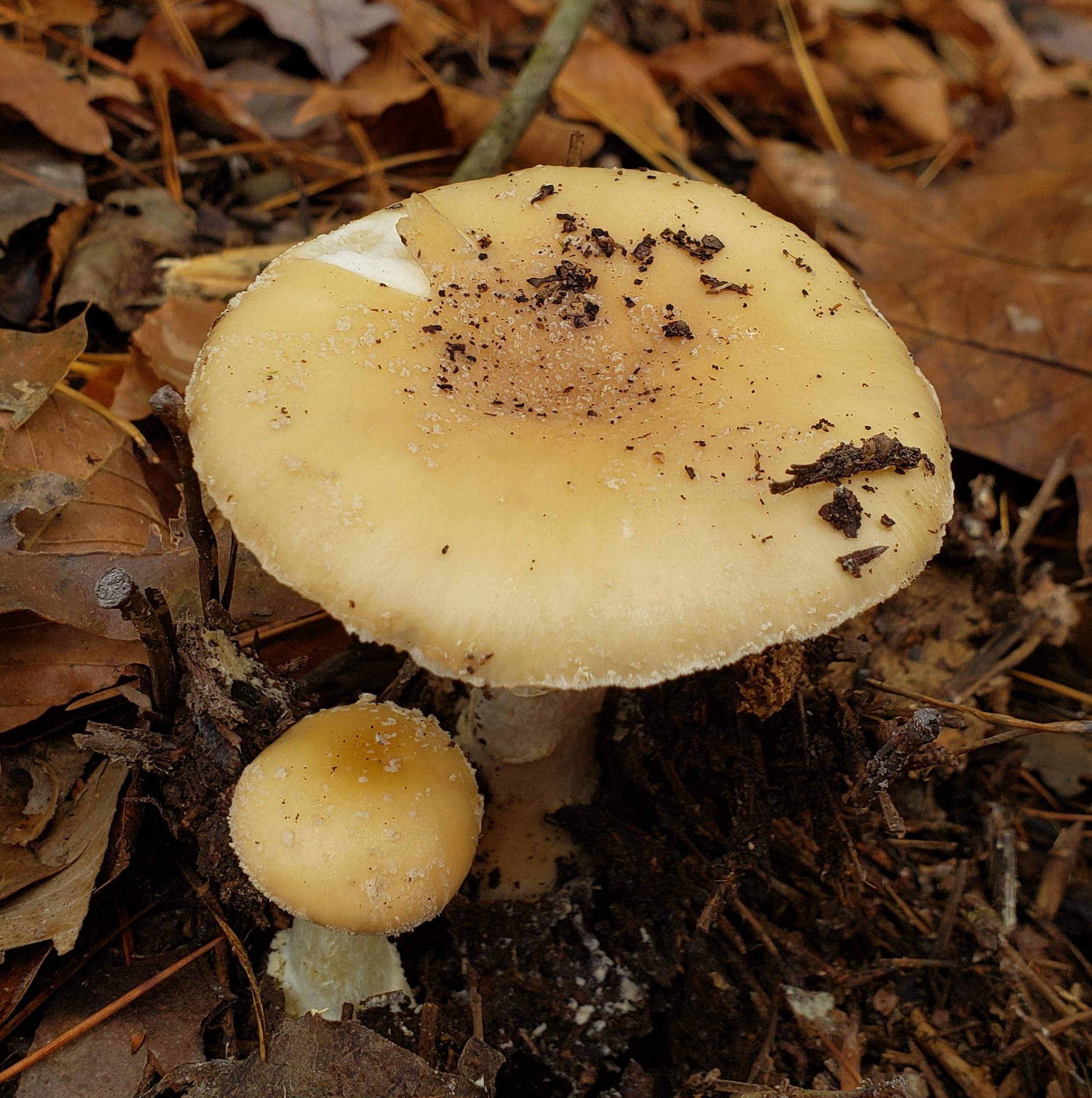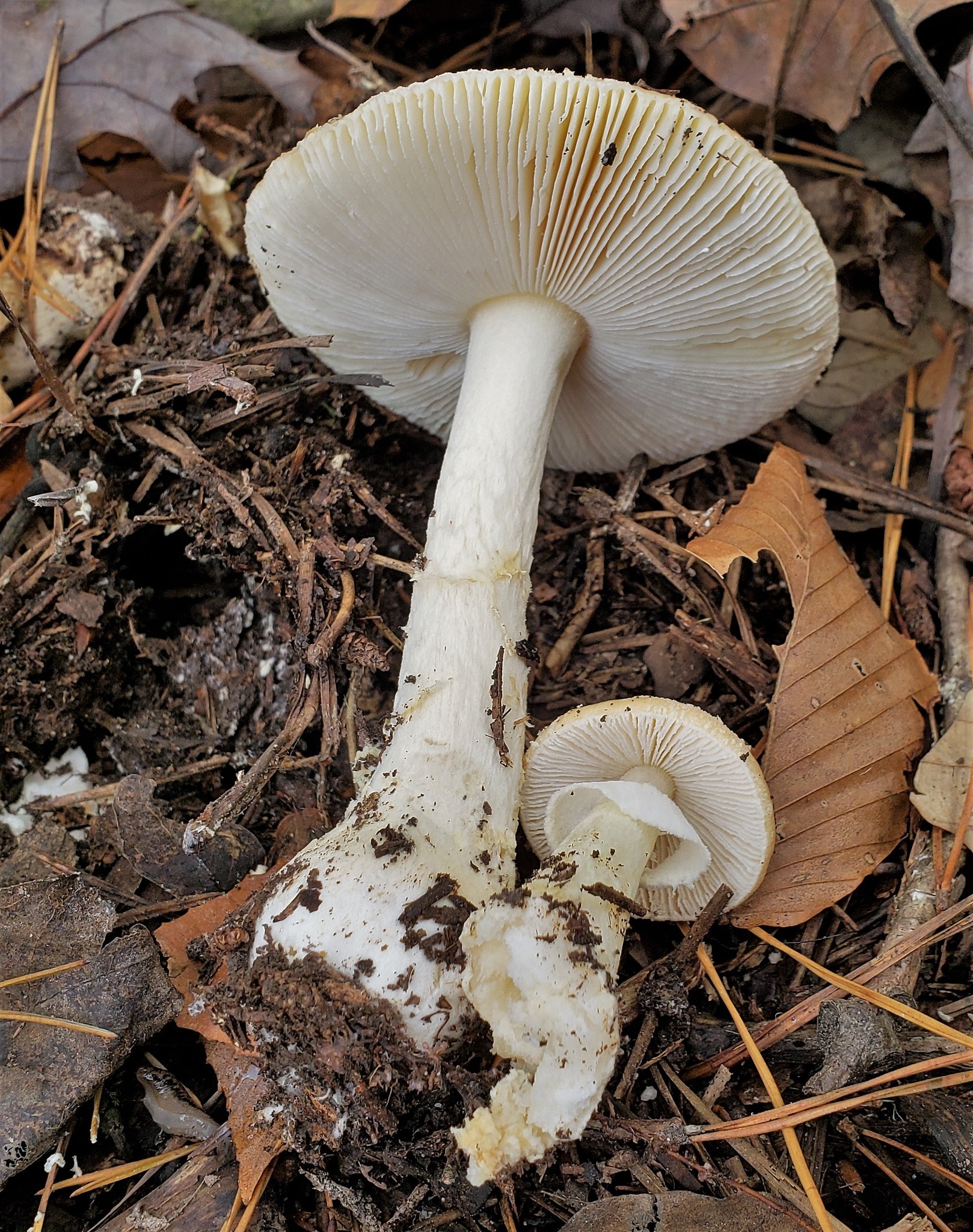Map Snapshot








22 Records
Status
Found on the ground in mixed forests.
Description
Grayish-buff cap with thin pale warts; margin lined in age; white flesh stain slightly yellow. Stalk white, woolly; white ring may disappear; bulb has some volval remains (J. Solem, pers. comm.).
Seasonality Snapshot
Eating mushrooms can be dangerous. One should do so only with expert advice and great care. MBP accepts no liability for injury sustained in consuming fungi or other biodiversity. Use of media featured on Maryland Biodiversity Project is only permitted with express permission of the photographer.
An Amanita crenulata in Howard Co., Maryland (10/11/2011).
Media by
Joanne Solem.
Cap of an Amanita crenulata in Howard Co., Maryland (10/11/2011).
Media by
Joanne Solem.
Amanita crenulata in Anne Arundel Co., Maryland (10/30/2020). (c) Matthew Beziat, some rights reserved (CC BY-NC).
View Record Details
Media by
Matthew Beziat.
Amanita crenulata in Anne Arundel Co., Maryland (10/30/2020). (c) Matthew Beziat, some rights reserved (CC BY-NC).
View Record Details
Media by
Matthew Beziat.
Amanita crenulata in Prince George's Co., Maryland (10/28/2020). (c) Matthew Beziat, some rights reserved (CC BY-NC).
View Record Details
Media by
Matthew Beziat.
Amanita crenulata in Anne Arundel Co., Maryland (10/11/2020). (c) Matthew Beziat, some rights reserved (CC BY-NC).
View Record Details
Media by
Matthew Beziat.
Amanita crenulata in Prince George's Co., Maryland (10/28/2020). (c) Matthew Beziat, some rights reserved (CC BY-NC).
View Record Details
Media by
Matthew Beziat.
Amanita crenulata in Howard Co., Maryland (7/13/2016). (c) Joanne and Robert Solem, some rights reserved (CC BY-NC).
View Record Details
Media by
Joanne Solem.
Amanita crenulata in Howard Co., Maryland (7/13/2016). (c) Joanne and Robert Solem, some rights reserved (CC BY-NC).
View Record Details
Media by
Joanne Solem.
Amanita crenulata in Howard Co., Maryland (7/13/2016). (c) Joanne and Robert Solem, some rights reserved (CC BY-NC).
View Record Details
Media by
Joanne Solem.
Spores from Amanita crenulata in Howard Co., Maryland (7/13/2016). (c) Joanne and Robert Solem, some rights reserved (CC BY-NC).
View Record Details
Media by
Joanne Solem.
Amanita crenulata in Howard Co., Maryland (7/13/2016).
View Record Details
Media by
Joanne Solem.
Spores collected from a specimen of Amanita crenulata in Howard Co., Maryland (10/11/2011). Nearly round/broadly ellipsoid; measured 8.4-11.4 X 7.1-8.8 microns.
Media by
Robert Solem.
Spores from Amanita crenulata in Howard Co., Maryland (7/13/2016). Ellipsoid, smooth; measured 7.5-8.6 X 6.6-8.1 microns.
View Record Details
Media by
Robert Solem.
Source: Wikipedia
| Amanita crenulata | |
|---|---|

| |
| Scientific classification | |
| Domain: | Eukaryota |
| Kingdom: | Fungi |
| Division: | Basidiomycota |
| Class: | Agaricomycetes |
| Order: | Agaricales |
| Family: | Amanitaceae |
| Genus: | Amanita |
| Species: | A. crenulata
|
| Binomial name | |
| Amanita crenulata Peck (1900a)
| |
| Amanita crenulata | |
|---|---|
| Gills on hymenium | |
| Cap is flat | |
| Hymenium is adnate | |
| Stipe has a ring | |
| Spore print is white | |
| Ecology is mycorrhizal | |
| Edibility is poisonous or psychoactive | |
Amanita crenulata, also known as the poison champagne amanita,[1] is a species of fungus that is very common in the Northeast United States.
Description
[edit]- Cap: 2 – 9 cm wide, hemispheric at first, then becoming flatter. Pale tan, sometimes grayish or yellowish. The volva is distributed over the wide cap as powdery, somewhat paler warts. The color of the warts lends the mushroom the name "champagne."
- Gills: narrowly adnate, close to subcrowded, and white to cream. The short gills are truncate to subtruncate or (occasionally) subattenuate.[2]
- Stipe: The stipe is 17 - 100 × 3.5 - 16 mm and has a skirt-like annulus that is often quickly lost or left in torn fragments on the pileus margin. The notable bulb usually bears a distinct ring of champagne volval powder on its "shoulder."[2]
- Odour: Not distinct.
It is an ectomycorrhizal fungus, living in root symbiosis with a tree.
Biochemistry
[edit]Amanita crenulata when ingested can produce symptoms associated with ibotenic acid/muscimol toxicity.[3][4]
See also
[edit]References
[edit]- ^ "Standardized Common Names for Wild Species in Canada". National General Status Working Group. 2020.
- ^ a b Amanita crenulata at amanitaceae.org Accessed Sep 2019
- ^ Amanita crenulata a common poisonous misunderstood mushroom p.1
- ^ Phillips, Roger (2010). Mushrooms and Other Fungi of North America. Buffalo, NY: Firefly Books. p. 25. ISBN 978-1-55407-651-2.
External links
[edit]- Amanita crenulata at amanitaceae.org
- Powdery Amanitas, at mushroomthejournal.com
- "Amanita crenulata, a common, poisonous, misunderstood mushroom," R. Tulloss, 1990, accessed Sep. 2019















